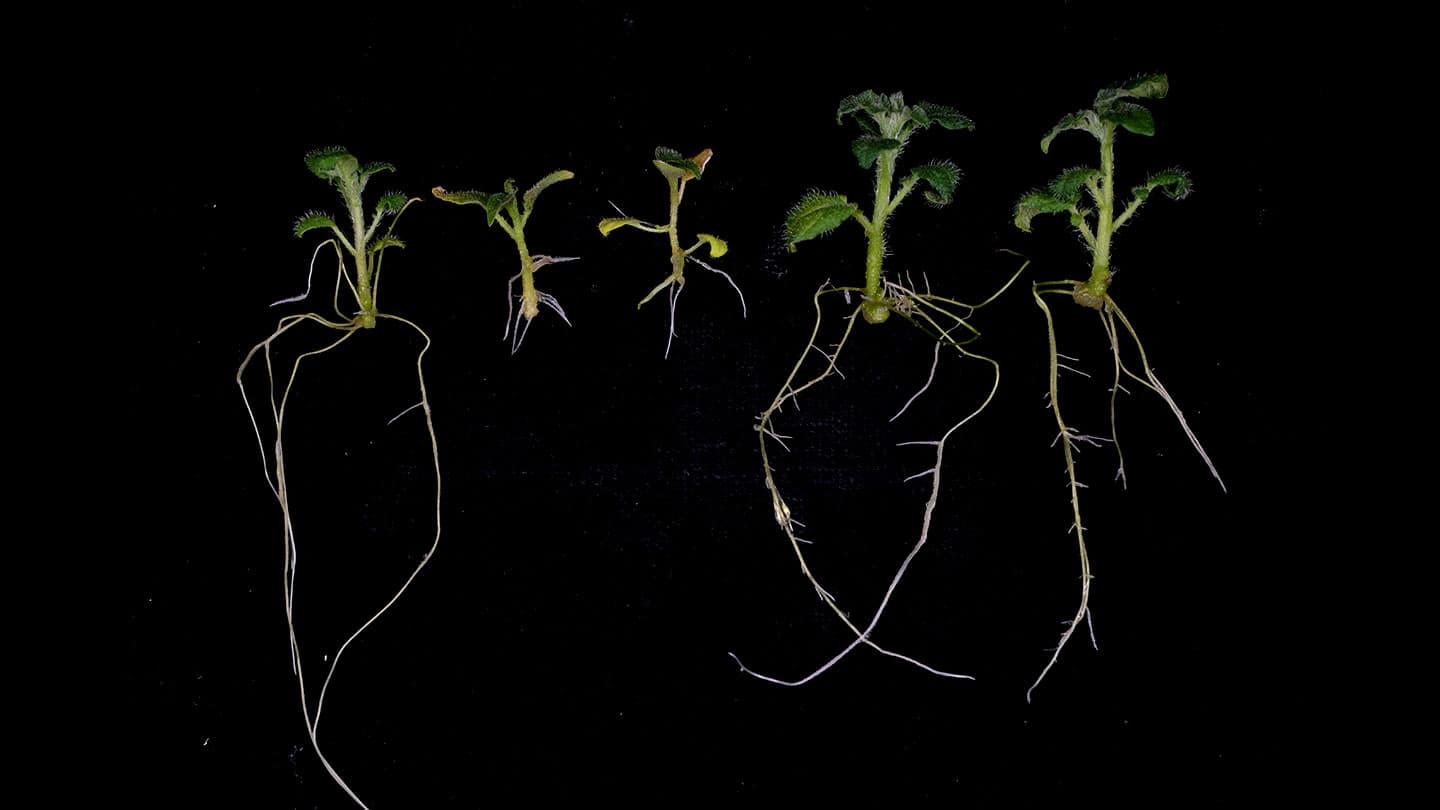Exploiting a genetic quirk in potatoes may cut fertilizer needs

A gene that controls when potato vegetation assemble their tubers also limits nitrogen uptake

Genetically modified vegetation with the silenced StCDF1 gene (factual) fared significantly better in low-nitrogen stipulations than control vegetation (left) and vegetation with an overexpressed StCDF1 gene (heart and heart-left), exhibiting that StCDF1 limits nitrogen uptake.
Maroof Ahmed Shaikh
Potatoes are the third-most consumed meals worldwide and a luscious snack. However neatly-liked farm potatoes require shining amounts of nitrogen within the assemble of nitrate fertilizers, that are costly and may perchance well well perchance furthermore be environmentally inappropriate.
A neighborhood of researchers has came upon that the same genetic mechanism that tells potatoes when to develop plants and tubers (the suitable for eating share) shall be a key player within the plant’s nitrogen management. The findings, described November 6 in New Phytologist, may perchance well well perchance furthermore lead to the approach of potato forms that require much less fertilizer, saving farmers money and lowering the environmental footprint of potato cultivation.
Potatoes, native to the Andes, within the beginning grew tubers easiest staunch through winter as a manner to store nutrients, taking cues from the shortening of the days. The vegetation due to this fact faced a prime wretchedness when presented to Europe within the 16th century. Shorter winter days got here along with freezing temperatures that killed the vegetation earlier than they would well furthermore fair develop shining potatoes.
At closing, a pure genetic mutation within the gene StCDF1, which controls tuber development, helped the potato vegetation adapt to develop tubers any time and much farther north. The vegetation no longer wished seasonal cues.
Researchers learning StCDF1 to brand the method in which it regulates the plant’s response to the daylight cycle came upon that it in actuality works like a swap, activating certain genes while turning others off. However they were bowled over to search out that it’s going to swap on and off genes compulsory for nitrogen uptake, says Maroof Ahmed Shaikh, a plant molecular biologist on the Centre for Research in Agricultural Genomics in Barcelona. Crucially, StCDF1 shuts off the manufacturing of an enzyme called nitrate reductase, which breaks down nitrate molecules so they would well furthermore be extinct by the plant.
This discovery shows that the genetic tweak that allowed potatoes to turn out to be a global staple meals also made the vegetation more fertilizer-hungry.
To take a look at if tweaking this gene would relish an stamp on nitrogen uptake, the researchers grew potato vegetation with a disabled StCDF1 gene in a low-nitrogen atmosphere — about 400 instances much less than conventional soil — and studied how they fared when put next with popular potato vegetation. The StCDF1-deficient vegetation may perchance well well perchance no longer develop tubers, but they produced higher leaves and longer roots despite the dearth of nitrogen. “They looked delighted,” says Shaikh.
The Andean forms presumably had a much less stuffed with life StCDF1 gene and may perchance well well perchance develop better with much less nitrogen, the crew explains.
However, it’s the more stuffed with life assemble of StCDF1 that’s most neatly-liked in all of the commercial potato forms grown worldwide. The change-off: The staple cut is harmful at assimilating nitrogen, says plant biologist Salomé Prat, also of the Centre for Research in Agricultural Genomics. “That is a wretchedness,” resulting from it leads farmers to utilize more fertilizer than the plant can absorb, Prat says. “When it rains, this extra fertilizer goes to groundwaters, polluting them.”
The finding opens the door to constructing potato forms with increased nitrogen efficiency. The researchers are planning to utilize gene-modifying tactics to tweak the gene that produces the nitrate reductase enzyme, so it’s no longer repressed by StCDF1. The crew has performed experiments exhibiting that here is theoretically that you are going to be ready to deem. This similar aim would be carried out the use of traditional breeding, crossing farm potatoes with wild or traditional forms that naturally relish altered nitrate reductase genes.
“Nitrogen uptake is without doubt one of the main major barriers in agriculture,” says Stephan Pollmann, a plant biologist on the Centro de Biotecnología y Genómica de Plantas in Madrid who wasn’t concerned with the fresh glimpse. Beyond being scientifically attention-grabbing, the very fact that here is in potato, a reliable cut grown worldwide that is main to meals security, makes this finding presumably a “smasher,” Pollmann says. “While you occur to’ll be ready to toughen the nitrate assimilation, so the nutrition of the plant, which is able to in result present you with higher tubers, here is sizable important.”
Extra Tales from Science News on Agriculture

